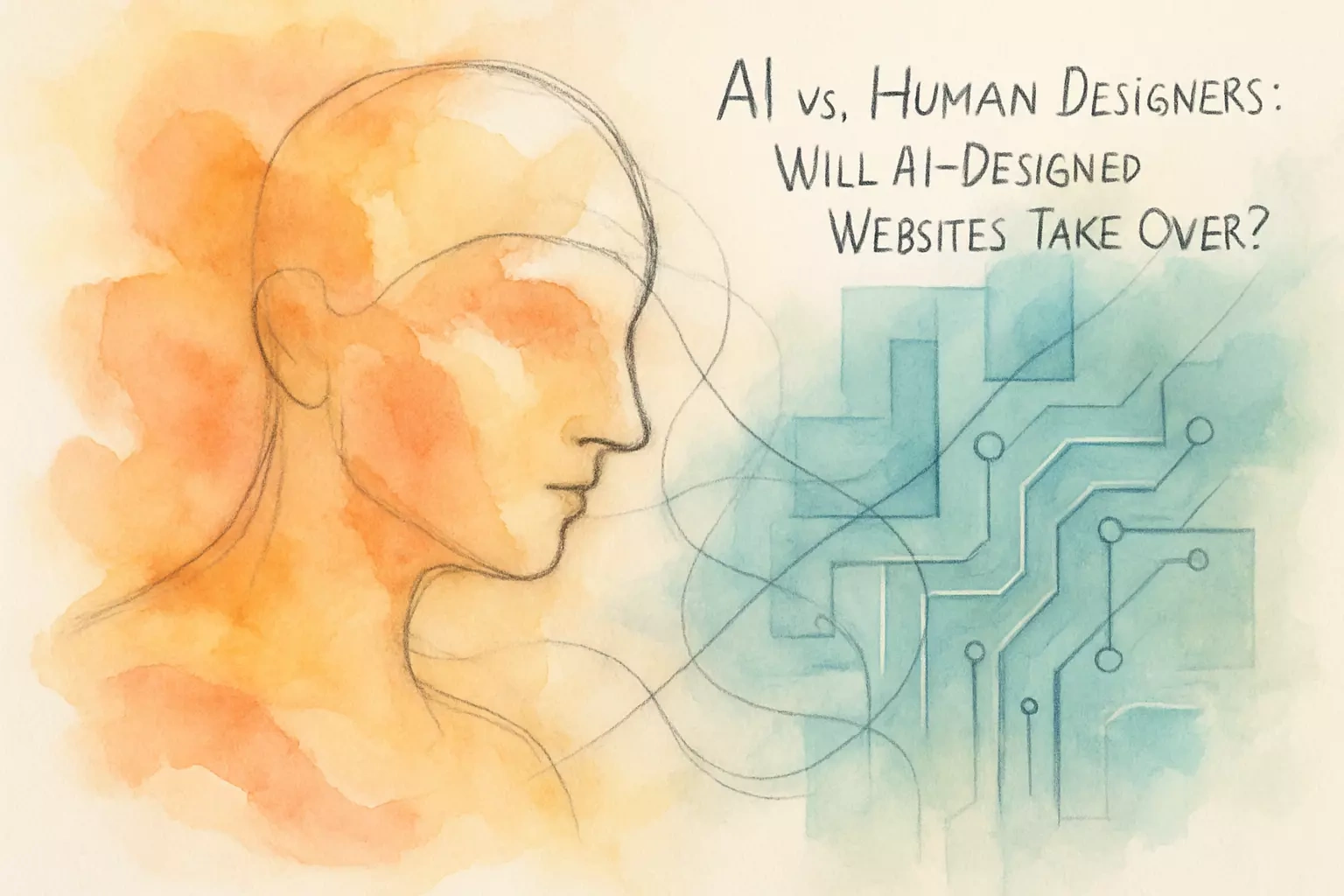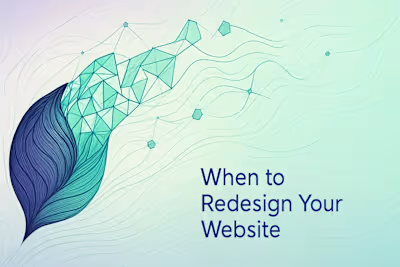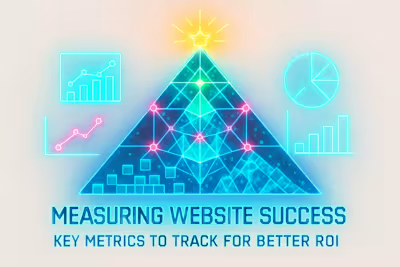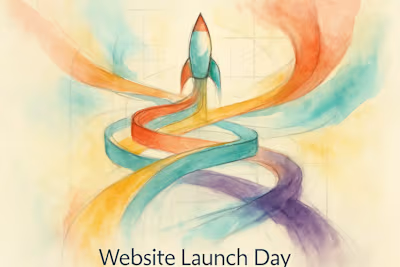AI vs. Human Web Designers: Will AI-Designed Websites Take Over?

AI vs. Human Web Designers: Will AI-Designed Websites Take Over?
The Rise of AI in Web Design
How AI is Automating Design Tasks
AI for Enhanced Personalization
The Pros: Where AI-Powered Design Shines
Efficiency, Speed, and Cost-Effectiveness
Data-Driven Optimization and A/B Testing
Improved Accessibility
The Cons: Where Human Designers Still Reign Supreme
Lack of True Creativity and Originality
Limited Understanding of Nuance and Context
Potential for Bias and Security Risks
The Future: A Collaborative Approach
References
AI vs. Human Web Designers: Will AI-Designed Websites Take Over?
The web design world is buzzing with a question that's keeping many designers up at night: Is artificial intelligence about to steal their jobs? It's a fair concern. AI tools are getting smarter every day, churning out website designs in minutes that used to take hours or even days. But before you panic about robots taking over the creative world, let's dig into what's really happening.
Here's the thing - AI in web design isn't quite the job-stealing monster some make it out to be. Instead, it's shaping up to be more like a super-powered assistant that handles the boring stuff while humans focus on the creative magic. As we explore the Top Web Design Trends of 2025, AI integration stands out as a game-changer that's transforming how websites come to life. Whether you're looking to hire professional web designers or wondering if you even need to anymore, understanding this AI revolution is crucial.
The Rise of AI in Web Design
Remember when building a website meant coding everything from scratch? Those days feel like ancient history now. AI has burst onto the scene, transforming web design from a purely human craft into something that feels almost magical. Today's AI tools can whip up entire website layouts, suggest color schemes that actually work, and even write content that doesn't sound like a robot wrote it (most of the time, anyway).
Take tools like Wix ADI or Bookmark's AIDA, for example. These platforms ask you a few questions about your business, and boom - they generate a complete website design in minutes. It's not just about templates anymore. These AI systems analyze millions of existing websites to understand what works and what doesn't. They're learning from every click, every scroll, and every conversion across the web.
The growth has been explosive. Just five years ago, AI in web design was mostly experimental. Now? Major companies are betting big on it. Adobe's Sensei, Figma's AI features, and countless startups are pushing the boundaries of what machines can create. We're seeing AI handle everything from generating hero images to optimizing navigation menus based on user behavior patterns.
How AI is Automating Design Tasks
Let's get specific about what AI actually does in the design process. First up: layout generation. AI can analyze your content and automatically create responsive layouts that work across all devices. No more manually adjusting breakpoints or wondering if your design looks good on that weird tablet size nobody talks about.
Color schemes used to require a designer's trained eye. Now, AI algorithms can generate palettes based on color theory, brand guidelines, and even emotional responses. Need a trustworthy blue for your finance site? AI's got you. Want something edgy for your streetwear brand? It'll suggest combinations you might never have considered.
But here's where it gets really interesting. AI excels at the repetitive stuff that makes designers want to pull their hair out. Resizing images for different platforms? Automated. Creating variations of the same banner for A/B testing? Done in seconds. Optimizing load times by compressing files just right? AI handles it without breaking a sweat.
The user experience optimization is particularly impressive. AI tools can track how visitors interact with your site and automatically adjust elements to improve engagement. If users consistently miss a call-to-action button, AI might suggest making it bigger or moving it to a more prominent spot. It's like having a UX researcher working 24/7, except this one never needs coffee breaks.
AI for Enhanced Personalization
This is where AI really flexes its muscles. Personalization isn't just about slapping someone's name on a webpage anymore. Modern AI systems create entirely different experiences for different users, all happening in real-time.
Picture this: Sarah visits an e-commerce site at 2 PM on her lunch break. The AI notices she's browsing quickly, probably pressed for time. It streamlines the navigation, highlights express shipping options, and shows her popular items that other lunch-break shoppers have loved. Meanwhile, Tom visits the same site at 9 PM from his couch. The AI serves him a more relaxed browsing experience with detailed product descriptions and customer reviews front and center.
The personalization goes deeper than timing. AI analyzes past behavior, demographic data, and even external factors like weather or local events. A fitness website might emphasize indoor workouts when it's raining in your area. A restaurant site could highlight comfort food during cold snaps or fresh salads when summer hits.
What's wild is how subtle these changes can be. AI might adjust font sizes based on user age demographics, change button colors to match preferences learned from previous interactions, or reorganize entire page layouts based on what similar users found most helpful. It's personalization at a scale no human team could manage manually.
The Pros: Where AI-Powered Design Shines
Let's talk about why businesses are jumping on the AI bandwagon faster than you can say "machine learning." The benefits are real, tangible, and often dramatic. AI isn't just a fancy buzzword - it's delivering results that make CFOs smile and project managers breathe easier.
Efficiency, Speed, and Cost-Effectiveness
Time is money, and AI saves buckets of both. What used to take a design team weeks can now happen in hours or even minutes. Small businesses that couldn't afford custom web design suddenly have access to professional-looking sites at a fraction of the cost.
Consider the traditional web design process. Client meetings, mood boards, multiple revisions, back-and-forth emails about whether the logo should be 2 pixels bigger - it all adds up. AI cuts through this like a hot knife through butter. Input your requirements, and you get a working prototype almost instantly. Need changes? Adjust a few parameters and regenerate. No hurt feelings, no creative differences, just results.
The cost savings are staggering. Where a custom website might run $5,000 to $50,000 or more, AI-powered solutions can deliver something workable for under $500. Sure, it might not win design awards, but for many businesses, "good enough" at 10% of the cost is a no-brainer.
Speed matters too, especially in today's market. Launching a new product? AI can have your landing page live before your competitors even finish their first design meeting. Need to test different markets? Spin up localized versions in multiple languages without hiring translators or regional designers. The efficiency gains compound quickly.
Data-Driven Optimization and A/B Testing
Here's where AI really earns its keep. Humans make design decisions based on experience, intuition, and best practices. AI makes decisions based on cold, hard data from millions of user interactions. Guess which approach typically performs better?
AI doesn't just run A/B tests - it runs them constantly, automatically, and at a scale that would drive human testers insane. While you're sleeping, AI might be testing 50 different button colors, analyzing click-through rates, and implementing the winner before you wake up. It's like having an army of conversion optimization experts working around the clock.
The insights go beyond simple metrics. AI can identify patterns humans might miss. Maybe users from mobile devices prefer a different layout than desktop users, but only during evening hours and primarily for certain product categories. Good luck spotting that trend manually. AI catches these nuances and adjusts accordingly.
Predictive analytics take this even further. Based on early user interactions, AI can predict which design elements will likely succeed or fail. It's not just reacting to data - it's anticipating user needs before they're fully expressed. This proactive approach to optimization can dramatically improve conversion rates and user satisfaction.
Improved Accessibility
This might be AI's most underappreciated superpower. Creating truly accessible websites is hard. There are countless guidelines, standards, and edge cases to consider. Many human designers, despite best intentions, miss crucial accessibility features. AI doesn't.
Automated alt text generation ensures every image has a description for screen readers. AI can analyze images and create meaningful descriptions that go beyond "image of product." It understands context, identifying not just what's in the image but why it matters to the user.
Color contrast checking happens automatically. AI ensures text remains readable for users with visual impairments, adjusting colors in real-time if needed. It can even simulate different types of color blindness to ensure your design works for everyone.
Navigation optimization for keyboard users, proper heading structures for screen readers, and ensuring interactive elements are large enough for users with motor impairments - AI handles all of this without being asked. It's like having an accessibility expert built into every design decision.
The Cons: Where Human Designers Still Reign Supreme
Now for the reality check. Despite all the hype, AI has some serious limitations that keep human designers firmly in the driver's seat. These aren't just temporary technical hurdles - they're fundamental challenges that touch the very essence of what makes great design great.
Lack of True Creativity and Originality
Here's the uncomfortable truth about AI: it's really good at remixing existing ideas but terrible at creating genuinely new ones. Every AI-generated design is essentially a sophisticated collage of things it's seen before. It can't have that "aha!" moment where a designer connects two unrelated concepts to create something revolutionary.
Think about the most memorable websites you've visited. The ones that made you stop and say "wow." Chances are, they broke conventions in ways AI would never consider. They took risks, made bold choices, and reflected a unique vision that came from human creativity and experience.
AI operates within parameters. It follows rules, even when those rules are complex and learned from data. But great design often comes from breaking rules intelligently. A human designer might intentionally use "wrong" colors to create tension, or break grid layouts to draw attention. AI sees these as errors to be corrected, not creative choices to be celebrated.
Brand storytelling is another area where AI falls flat. A skilled designer doesn't just make things look pretty - they weave a brand's personality, values, and story into every pixel. They understand the emotional journey they want users to take. AI can mimic the surface-level aesthetics of successful brands, but it can't capture the soul that makes them resonate with people.
Limited Understanding of Nuance and Context
Context is everything in design, and AI struggles with the subtle stuff. Sure, it knows that law firms typically use conservative designs while creative agencies go wild. But what about a law firm that specializes in helping artists? Or a creative agency that works exclusively with Fortune 500 companies? These nuances require human understanding.
Cultural sensitivity is another minefield for AI. What works in one market might be offensive or confusing in another. Colors, symbols, and even layout directions carry different meanings across cultures. A human designer researches, empathizes, and adapts. AI just applies patterns it's learned, sometimes with cringe-worthy results.
Strategic thinking remains firmly in the human domain. AI can optimize for metrics, but it can't understand business strategy. It doesn't know that your startup is pivoting from B2C to B2B, or that your brand is trying to appeal to a younger demographic without alienating existing customers. These strategic considerations require human insight and judgment.
The emotional intelligence gap is perhaps the biggest limitation. Humans design for humans, understanding fears, desires, and motivations that go beyond data points. We know when to add humor, when to be serious, and when to surprise. AI treats these as variables to be optimized, missing the human touch that makes designs truly connect.
Potential for Bias and Security Risks
Here's where things get a bit dark. AI learns from existing data, and that data reflects all our human biases. If historically successful websites have catered to certain demographics, AI will perpetuate those patterns. It's not intentionally discriminatory, but the results can be just as harmful.
Imagine an AI trained on e-commerce sites that have traditionally targeted affluent shoppers. It might automatically create designs that feel exclusionary to budget-conscious consumers. Or consider AI that's learned from tech industry websites - it might default to designs that assume high technical literacy, leaving less tech-savvy users behind.
Privacy concerns are real and growing. AI-powered personalization requires data - lots of it. Every click, scroll, and hover gets tracked, analyzed, and stored. While this enables amazing personalization, it also creates privacy risks. Data breaches, unauthorized sharing, and the general creepiness of being tracked everywhere online are genuine concerns.
Security vulnerabilities in AI systems pose another risk. As these tools become more prevalent, they become bigger targets for hackers. A compromised AI system could inject malicious code into thousands of websites simultaneously. The centralized nature of many AI platforms creates single points of failure that don't exist with traditional design approaches.
The Future: A Collaborative Approach
So where does this leave us? Are designers doomed to obsolescence, or is AI just another overhyped tech trend? The answer, as usual, lies somewhere in the middle. The future of web design isn't about AI versus humans - it's about AI with humans.
Think of AI as the ultimate design assistant. It handles the grunt work, freeing designers to focus on what they do best: creative problem-solving, strategic thinking, and human connection. Instead of spending hours on repetitive tasks, designers can invest that time in understanding clients, researching users, and crafting experiences that truly matter.
We're already seeing this collaboration in action. Designers use AI to generate initial concepts, then refine and elevate them with human creativity. They let AI handle responsive scaling while they focus on the overall vision. They use AI-powered analytics to inform decisions but apply human judgment to interpret the data.
The most successful designers of the future won't be those who resist AI or those who rely on it entirely. They'll be the ones who master the art of human-AI collaboration. They'll know when to let AI take the wheel and when to grab it back. They'll use AI to amplify their creativity, not replace it.
This collaborative approach extends beyond individual designers. Agencies are restructuring around AI integration, with humans handling strategy, creativity, and client relationships while AI manages production, optimization, and analysis. It's not about fewer jobs - it's about different jobs that leverage uniquely human skills.
The tools will keep improving. AI will get better at understanding context, generating original ideas, and working seamlessly with human designers. But the need for human creativity, empathy, and strategic thinking isn't going anywhere. If anything, as AI handles more routine tasks, these human skills become more valuable.
Looking ahead, we might see AI that truly understands brand strategy, or systems that can engage in creative collaboration rather than just following instructions. But even then, the human element remains crucial. Someone needs to set the vision, make the tough calls, and ensure the final product serves human needs in meaningful ways.
The bottom line? AI is transforming web design, but it's not taking over. It's creating new opportunities for designers who adapt, learn, and embrace collaboration. The future belongs to those who see AI not as a threat but as a powerful ally in creating better, more human-centered web experiences.
For businesses, this means the choice isn't between AI or human designers - it's about finding the right balance for your needs. Sometimes an AI-generated site is perfect. Sometimes you need the human touch. Often, you need both. The key is understanding what each brings to the table and leveraging their strengths accordingly.
As we move forward, one thing is certain: the web design landscape will continue evolving. New tools will emerge, capabilities will expand, and the line between human and AI contributions will blur. But at the heart of great web design will always be the goal of creating meaningful connections between brands and people. And that's something that requires both the efficiency of AI and the irreplaceable spark of human creativity.
References
Like this project
Posted Jun 30, 2025
Explore the rise of AI in web design. We analyze how AI tools are creating websites and whether they can truly rival the creativity and strategic thinking of human web designers.











